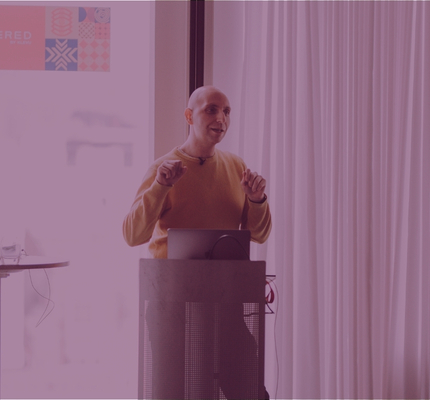
TV
Unlocking the Potential of Ecommerce Personalization
The dynamic world of personalization took center stage at Discovered London where experts had some thought-provoking disscussions about unlocking the full potential of personalization in the digital age.

The dynamic world of personalization took center stage at our recent Discovered London Conference where experts in personalization from diverse fields came together for an insightful panel discussion. The panel featured accomplished professionals working in personalization space, who shared their perspectives on current trends and future possibilities in the realm of personalization.
The panelists included Vitaly Friedman, the co-founder and editor-in-chief of Smashing Magazine, a leading online publication for designers and developers; David Mannheim, the founder of Made with Intent, a strategic design and user experience agency; Rasmus Houlind, CEO of Agilic, and also the author of new book about personalization called “Hello $FirstName”; Gianfranco Cuzziol who is working with Natura & Co with four iconic brands – Aesop, Avon, Natura and the Body Shop; and also Rob Boland, the Senior Solutions Architect at Klaviyo, a marketing automation platform for email and SMS. Each panelist brought their unique perspectives to the table, providing valuable insights and stimulating thought-provoking discussions.
In this article, we’ll delve into the key takeaways from this enlightening panel discussion, exploring the ideas and predictions shared by these digital industry leaders as they navigate the ever-changing landscape of innovation and technology.
What is ecommerce personalization and why does it matter
Personalization is a hot topic in today’s digital world, and it’s not hard to see why. Vitaly Friedman, the moderator of the panel, expressed his excitement about getting deep insights on the dos and don’ts of personalization. Panelists first shared their view on what personalization is to them and if they think there is a unique definition we can all follow.
When David Mannheim first started writing his book he had a quest to define personalization. After looking at all these different definitions, the main thing he learned was that we do not need to define it. By defining personalization, it becomes something that’s binary, and he came to the conclusion that to him it’s more important to know why are we doing personalization in the first place. Gianfranco agreed by saying that ultimately, all marketers and technologists are here to meet the wants and needs of customers, and to get them from A to B. That’s why he thinks brands need to to what is right for the customer, but also what is right for the brand.
Rasmus, on the other hand, shared an opposite view to David’s. Vitaly discussed the importance of defining personalization in the context of marketing. He noted that there are various tribes of marketers, each working with personalization in different ways, such as through advertising, owned media campaigns, marketing automation, or product recommendations. While a broad definition of personalization may be necessary to encompass all these approaches, it’s essential to have a common understanding of what personalization means.
Without a clear definition, marketers may end up talking past each other and failing to collaborate effectively. By agreeing on a broad definition of personalization, marketers can begin to understand the different types and degrees of personalization and work together to improve the customer experience through tailored messaging and product recommendations.
What is a good personalization strategy
Well, according to Rasmus, a good personalization strategy begins with understanding the customer journey. He compared the customer journey to a long ribbon, with crucial moments of truth throughout. To keep the ribbon intact and create a positive customer experience, it’s important to not only repair any breaks but also tie a beautiful bow that adds value and delight.
Houlind’s “Hello: $FirstName” book model centers around this idea of the bow tie of personalization, where insights and content are combined to create personalized, memorable, and pleasurable experiences. By focusing on the critical parts of the customer journey and tailoring the experience to the customer’s needs, businesses can improve customer satisfaction and loyalty.
Personalization strategy at scale
Rob Boland stated that one of the little tricks he learned was to stop trying to personalize for everyone because you can’t do it for everyone. What you can do is turn it the other way around and let the customer personalize their own experiences.
He gives a great example that became a funny highlight to the panel. There’s a jumper company he’s working with called Sheep Inc. that uses a QR code and a game-like approach to engage customers. Customers scan the code on the sheep tag that comes with the product, which leads them to a site where they can personalize their relationship with the brand. They can pick a sheep, name it, and receive updates from a real time GPS trackers on sheep in fields that they have in New Zealand. He even named his sheep Molly and it made him feel so attached to the brand, while brand didn’t have to do any individual personalization, as the customers personalized it themselves.
The brand even created a Tamagotchi-style game where customers can feed their sheep. By allowing customers to personalize their own experiences, Sheep Inc. has created a deeper connection with its customers, making it personal and memorable for them. This approach not only removes the burden of trying to figure out what each customer wants, but it also creates an engaging and unique experience for each individual.
Gianfranco said that is a really nice take on personalization and that brand can learn a lot from the way that customers are personalizing by themselves. It is important for brands to remember and learn from the customers.
Emotional aspect of personalization
There are challenges of using personalization to drive business KPIs without sacrificing the emotional component of a brand. While personalization can be effective in driving sales and conversions, the focus on short-term profit can lead to a lack of long-term strategy.
David Mannheim, a big Disney fan, shared his thought on how pursuit of short-term profits can lead companies to focus on wrong things, such as nickel-and-diming their customers instead of creating meaningful experiences.
Mannheim admires companies that prioritize guest experiences over immediate revenue. He believes that companies need to have a clear sense of purpose to combat short-term thinking and prioritize long-term goals that benefit both the business and the customer. By doing so, companies can create emotional connections with their customers that drive loyalty and ultimately, long-term success.
Companies like Netflix have successfully used personalization for retention, rather than just acquisition, and attribute their success to a strong sense of purpose. To combat the overly commercial viewpoint of personalization, it’s important for companies to have a clear understanding of their purpose and why they’re doing what they’re doing. This purpose can guide decisions and help balance the short-term focus on profit with the long-term goal of building emotional connections with customers.
Are we exploiting value from customers
Rasmus Houlind believes that personalization is always about value creation from the company’s perspective. He suggests that using emotional tactics, such as the “sheep tactic” mentioned earlier in the panel by Rob, can create positive feelings towards a brand and lead to long-term customer lifetime value, even if it doesn’t result in immediate conversions.
By collecting data and sending personalized updates, companies have an excuse to stay in contact with customers and build brand loyalty. While some may argue that this approach is not strictly personalization, Houlind believes it is a valuable branding exercise that can benefit companies in the long run.
How to measure personalization
A good strategy in general is both short-term improvements and also long-term vision of what we want to be. But how do you really measure this emotional impact of personalization?
Gianfranco Cuzziol emphasized the importance of showcasing the impact of personalization on different metrics to different parts of the business. This includes metrics such as NPS, word of mouth, customer retention, and churn rates. However, in order to secure the necessary budget for personalization efforts, it’s crucial to prove the impact on revenue.
Cuzziol notes that while playing the long-term game is important, it’s also necessary to demonstrate short-term successes. This approach can help build momentum and provide evidence that personalization efforts are delivering value to the business. By showcasing the impact of personalization on a variety of metrics, marketers can effectively communicate the value of these efforts to key stakeholders in the organization.
David agreed with him, and said that he thinks there isn’t one single metric that can define personalization success. He also added that when presenting your ideas to key stakeholders, like CFOs, you have to be confident and experiment with different approaches and a combination of metrics.
According to Rob, focusing solely on sales can be a mistake. Instead, he suggests looking at other metrics, such as return rates and customer satisfaction. By analyzing these metrics, businesses can get a more complete picture of how well they are performing.
For example, a post-purchase flow that encourages customers to keep products longer can lead to a decrease in return rates, and a successful referral program. So while sales are important, it’s essential to remember to look beyond them and examine the other factors that contribute to a business’s success.
Skills required for teams working on personalization
Rasmus started by saying that personalization in marketing involves three main factors: people and skills, technology, and governance. The skills required for personalization depend on the department you work in and the type of personalization you’re implementing. For instance, personalization for websites would require specialists in UX and CX for web platforms or apps, while personalization within marketing automation would require specialists in email marketing, outbound marketing, and push notifications.
However, as you move up the maturity levels, things start to merge, and the focus shifts towards creating an omnichannel experience that benefits both the customer and the organization.
Ultimately, personalization starts in the inherent marketing disciplines and evolves into an approach that delivers the next best experience.
Gianfranco offered an example of how at Natura & Co they are looking at it from an omnichannel perspective and are currently setting up a global activation team that will take care of the customers, but also have people who will look at it from the technology perspective. Having that dual focus within global teams will enable them to put the customer first and then to try understand what are the right technologies that will support their customer vision. So it’s always customer first, and technology comes second.
Is personalization invasion of customer’s privacy
Vitaly, who actually also works with the European Parliament, believes that personalization is not just about collecting data but also about respecting the customers’ privacy. With the rise of privacy concerns, companies need to be careful about the data they collect and how they use it.
Vitaly highlights an example of an unethical decision by a company that customized the offboarding experience to make it harder for customers to leave, cancel a plan or close an account. He considers this practice deceptive and wonders about the balance between collecting data and respecting customers’ privacy. Personalization depends on having the right amount of data about customers, but it should not be at the expense of their privacy.
David argues that personalization comes down to putting the customer first. He references Amazon’s Jeff Bezos as a pioneer of personalization who prioritizes the customer by tailoring stores to individual needs. However, Bezos also famously stated “your margin is my opportunity,” which can lead to businesses prioritizing profits over customers.
David also mentioned the recent EU commission fine of 900 million pounds against Amazon for prioritizing higher margin products over customer needs in their recommendations algorithm. He believes that regulations like these force businesses to be more creative in their practices and prioritize the customer over profits. Personalization should always be customer-first and that regulations are a positive force for promoting ethical practices.
The stage of over-personalizing
Vitaly raises an important question about the future of AI and its impact on personalization. As we continue to collect more data, the possibilities for personalization are endless. However, he wonders if we will reach a point where personalization becomes too invasive for customers. Will they feel uncomfortable with the level of personalization and the amount of information being collected about them? He notes that sometimes it’s hard to tell if a message is personalized or general, which raises concerns about transparency.
It’s important to consider the balance between personalization and privacy to avoid crossing ethical boundaries. We need to ensure that personalization serves the customers’ interests while respecting their privacy, and that customers have control over the amount of personal data they share.
Explicit vs. implicit personalization
Gianfranco highlights examples of both good and bad personalization. On one hand, he praises Spotify’s “Wrapped” feature, which tells users about their music tastes and offers live music recommendations. But on the other hand, he describes receiving an email from a coffee shop about his coffee consumption over a month, which actually lead him to stop drinking coffee, which was clearly not the coffee shop’s intention. Gianfranco emphasizes the importance of personalization adding value to the customer experience rather than just do it because everyone is doing it.
Rasmus highlights that the sensation of creepiness in personalization comes from using data that the consumer is unaware of. Explicit personalization can be too touchy or too creepy, especially when companies use data that is too personal without consent. Instead, he suggests distinguishing between explicit and implicit personalization. Making it seem like a coincidence that the company is communicating about certain topics rather than directly showing that it is an act of personalization can be less creepy. However, when addressing touchy topics like divorce, it is best to be implicit or even ask customers to supply data voluntarily.
In general, personalization should add value to the customer experience without crossing the line of creepiness. Assumptions are super dangerous and can lead make a negative impact in customer’s behavior. There is a way to present these products, without making them the main story of the message sent to customers.
Final thoughts
As the panel discussion drew to a close, Vitaly asked the panelists to wrap their thoughts into a sentence or two and share with the audience. Here’s what they had to say.
“Personalization is the verb to be more personable. So be more personable.” – David Mannheim
“In the words of Mike Tyson, everyone has a plan until they get punched in the mouth. So it’s an evolution. You’ll never have the final solution from day one.” – Gianfranco Cuzziol
”Watch the space of generative AI and explore how that can help you create more content variance more easily, or even make that as a democratized process for your employees making that happen. I’m so curious to see how that’ll evolve.” – Rasmus Houlind
“I always say this stuff is really hard, so don’t hit yourself if you’re not doing it well. It’s actually really hard to do it, but don’t be afraid to try and do it. Think of my little sheep. Think of Molly, the sheep in the fields.” – Rob Boland
After, we had some questions from the audience and wrapped up the session. Overall, this was an amazing panel and we would like to thank all the panelists for being part of our Discovered event in London. Until next one!

